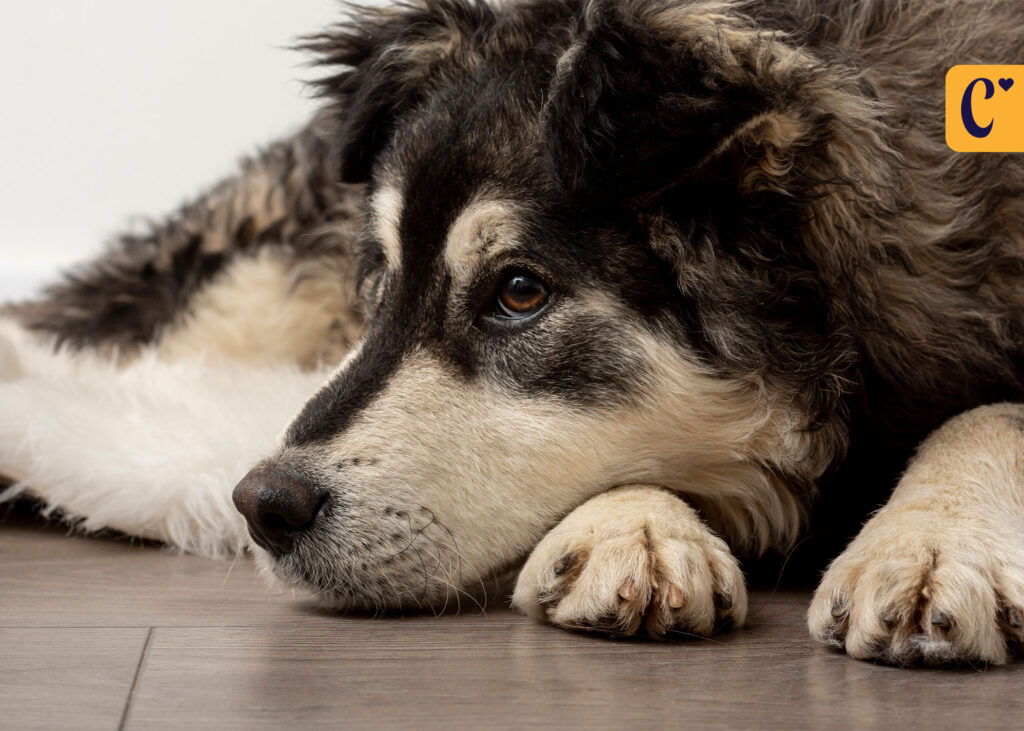Depression in humans is marked by a sense of persistent sadness and disinterest in daily life, however, in dogs, these clinical symptoms differ. Our loyal companions cannot communicate their feelings verbally, but hopefully, humans can keenly discern the physical indicators of depression in their four-legged friends.
Observing these behavioral shifts allows us to gauge our canine companions’ emotional well-being. Though dogs cannot vocalize their emotions, our deep connection with them enables us to detect and address their unspoken distress, fostering their mental and physical health.

What Causes Depression in Dogs?
In a 2019 Swedish study, researchers delved into the enduring stress hormone levels shared between humans and their pets, particularly dogs. Astonishingly, the findings revealed that dogs mirrored their owners’ stress levels. This revelation highlights the significant impact our emotions have on our canine companions. Not only can dogs discern our emotional states, but they also possess an uncanny ability to guess our happiness or sadness through astute analysis of our demeanor, speech, and body language.
It’s imperative to remain vigilant to your dog’s well-being, so if you notice concerning symptoms such as vomiting, diarrhea, pronounced lethargy, aggressive behavior, or skin rashes, a visit to the veterinarian is imperative.
Depression can strike dogs due to alterations in their daily routines, therefore, in this section, we present the 3 most prevalent triggers.
1. Death of a Loved one
Humans aren’t the only ones who experience the loss of a family member or companion animal. A dog’s high emotional intelligence leads to a high degree of intense feelings and helps them overcome the pain caused by the loss of a loved one. To ease the grieving process, it is important to give the dogs proper attention and time.
2. Change of Living Environment
Your companion animal’s behavior may change with a change in the living environment and continue until they get used to their new home. However, with some time and proper attention from you, your little friend will soon get used to the new environment and will be free from the symptoms of depression.
3. Spending Most of the Time Indoors
Like humans, dogs are social creatures, so spending many hours alone is emotionally difficult for them. Spending most of their time indoors, away from nature, the sun, and friends can take a serious toll on dogs’ mental health. However, we will reassure you and tell you that along with the feeling of freedom, your pet will quickly regain energy and will quickly regain the joy of life.
Signs of Depression in Dogs
Depending on the underlying cause, depression may manifest itself in different ways. For example, a companion animal who is depressed due to the loss of a companion will behave differently than a pet who is experiencing a change in living environment.
In 2016, a study conducted in New Zealand and Australia looked at signs of depression in dogs:
- Loss of appetite
- Increased sleepiness
- Lethargy
- Attachment to owners
- Territorial behavior
- Setting personal boundaries
- Change in vocalization
- Aggressive behavior toward people and other animals
- destructive behavior
Paying close attention to your dog and observing behavioral changes can assist in determining whether depression is the cause of the clinical symptoms your pet is exhibiting. For instance, canine cognitive dysfunction syndrome may present with depression-like symptoms. However, unlike depression, cognitive dysfunction syndrome is related to the aging of the dog’s brain and affects memory along with consciousness.
How to Help a Depressed Dog?
Like humans, depression and its associated consequences can be different for each dog. Fortunately, dogs are resilient creatures, and after a stressful event, even small positive changes can greatly improve their emotional state. For your inspiration, here are some ideas that you and your companion animal might find useful.
1. Increase the Frequency of the Mental and Physical Activity
If your companion animal is experiencing a deficit in interacting with other dogs, you can fill the void by scheduling mental and physical activities. In this case, adopting another dog would have a special effect, although it would be unwise to make this decision just to please your dog. Bringing a new pet into your home is an important decision that should be taken carefully.
2. Make Sure the Dog Eats a Balanced Diet
A sudden weight loss is observed in dogs during depression. To prevent this side effect, it is recommended to offer the dog high-quality balanced food. This positive change in nutrition will encourage your pet and significantly increase his happiness index. However, to avoid digestive problems associated with a sudden change in diet, it is advisable to change the food ration gradually.
3. Communicate Appropriately
You need special attention in the process of managing symptoms related to depression. Remember, punishing unwanted behavior will only make the problem worse. Especially when dealing with a pet suffering from depression or anxiety. Correct communication and proper understanding of the condition of the companion animal will undoubtedly speed up the process of curing depression.
Treatment for Depression
If depression is causing behavioral problems in your dog, you need to take extra care in managing the rehabilitation process. The process should be conducted by an experienced veterinarian. Taking into account the specific nuances of the dog’s condition, the veterinarian will prescribe a recommended course of treatment for your companion animal. This course may combine the following components:
- Prescription drugs
- behavior modification
- Environmental changes
- food additives
- Medical therapy
Depression medications are commonly prescribed along with nutritional supplements and pheromone products. Medical treatment is particularly effective for companion animals with a long history of fear or anxiety.
